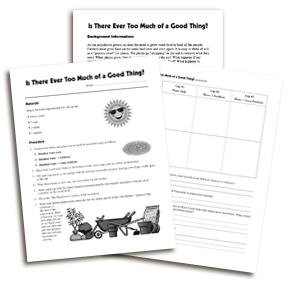Companion Resource

Is There Ever Too Much of a Good Thing?
This activity directs students in performing an experiment measuring the growth of beans using too much fertilizer, too little fertilizer, and the right balance of fertilizer. Students will learn how and why farmers use the correct amount and type of fertilizer to grow crops used for our food and fiber.
Time to Complete
Materials
For the class:
- Houseplant fertilizer: enough for 2-3 gallons
- Distilled water: 3-4 gallons
- Three, one-gallon plastic containers with lids to mix the following solutions. Once these solutions are made, pour them into the spray bottles, which students will use to water their plants (prevents over watering).
- One containing distilled water only
- One containing the recommended mixture of distilled water + fertilizer, mixed according to fertilizer package directions
- One containing distilled water + 5 times the recommended amount of fertilizer
- Large bucket containing a mixture of 1 part vermiculite to 1 part soil. Soil should be obtained from an area that has not been amended with fertilizers, compost, etc.
- Six labeled spray bottles (two each of the three liquids described above)
- Light source
For each of your 3 class groups:
- Nine bean seeds (use garden seeds, dried grocery store beans are not recommended)
- Three plastic or wax-lined paper cups (9 oz. size)
- Three write-on labels
- Colored pencils, crayons, or markers
- Is There Ever Too Much of A Good Thing? handout
- Pie tin or other container to hold plants for each group.
Preparation:
To ensure positive results, please note the following:
- Prior to this activity you will label and fill the spray bottles with each of the three pre-mixed liquids from the one gallon containers, allowing for easier student application.
- Use an equal mixture of clean vermiculite and soil. Obtain soil from an area that has not been amended with fertilizers, compost, etc. Do not use potting mix—it contains fertilizer and compost materials. A poor quality soil is ideal for this experiment. Mix the vermiculite and soil very well.
- Use distilled water. The minerals in tap water may lead to poor results. The soil and vermiculite mixture will dry out quickly. Instruct students to carefully monitor their cups to ensure they stay moist throughout the experiment.
- Plant at least three beans in each cup.
- Expected results are as follows:
- Distilled water only: some growth
- Distilled water + fertilizer: best growth
- Distilled water + extra fertilizer: poor or no growth
Procedures
- Ask students to brainstorm all of the plants they can think of that we eat. This list can include both plants we eat and fruit or nuts produced by plants. As student name plants, write them on the board. Likely your students will make a long list of fruits, vegetables, and nuts.
- With the list of plants on the board, draw on prior knowledge with the following questions:
- Do plants need nutrients to grow? (Yes)
- Where do plants receive their energy? (Photosynthesis)
- How do plants acquire nutrients? (They absorb nutrients from the soil)
- What happens if the nutrients naturally found in the soil are depleted? (Healthy plant growth will weaken or even cease)
- How can farmers return nutrients to the soil? (Through the use of fertilizer. There are many types and sources of fertilizer)
- If fertilizer helps plants grow, can you ever add too much fertilizer? (Yes)
- Tell students that they will be conducting an experiment to find out what happens to plants if they get too few or too many nutrients.
- Assign groups and distribute the Is There Ever Too Much of A Good Thing? handout and necessary materials. Model the instructions before letting the students begin, giving special attention to the number of sprays you would like student to use when watering their plants.
- Guide students as they collect their experimental data. Compare and discuss class results at the end of the experiment.
Variations
- Perform this lesson as a class project rather than in partnerships.
- Take a class or school-wide poll. Ask students to predict what will happen to the plant watered with extra fertilizer. After the experiment concludes, make graphs to show the results of the poll.
- Use young plants rather than seeds for the experiment: the results will be faster.
ELL Adaptations
- This lesson incorporates hands-on activities. Kinesthetic learning events provide an excellent learning environment for English language learners.
- Demonstrate how student groups need to set up their experiments and pair ELL students with other students who will model instructions.
- Add new vocabulary to a word wall and match photos to the new words.
File, Map, or Graphic
Author
Organization
Sources
This lesson was originally developed in 1993 through a partnership between the California Department of Food and Agriculture, California Farm Bureau Federation, Fertilizer Inspection Advisory Board, Fertilizer Research and Education Program and the California Foundation for Agriculture in the Classroom. It was updated in 2013 with funding from the California Foundation for Agriculture in the Classroom and a grant from the California Department of Food and Agriculture’s Fertilizer Research and Education Program.
Original Author: Pamela Emery
Executive Director: Judy Culbertson
Illustrator: Erik Davison
Layout and Design: Nina Danner
